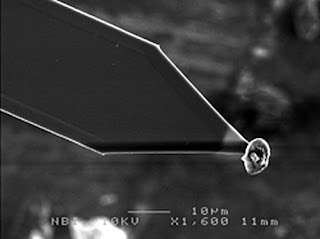The acidification of the world’s oceans could have major consequences for the marine environment. New research shows that coccoliths, which are an important part of the marine environment, dissolve when seawater acidifies. Associate Professor Tue Hassenkam and colleagues at the Nano-Science Center, University of Copenhagen, are the first to have measured how individual coccoliths react to water with different degrees of acidity.
Coccoliths are very small shells of calcium carbonate that encapsulate a number of species of alga. Algae plays an important role in the global carbon-oxygen cycle and thus in our ecosystem. Our seawater has changed because of our emissions of greenhouse gases and therefore it was interesting for Hassenkam and his colleagues to investigate how the coccoliths react to different types of water.
"We know that the world’s oceans are acidifying due to our emissions of CO2 and that is why it is interesting for us to find out how the coccoliths are reacting to it. We have studied algae from both fossils and living coccoliths, and it appears that both are protected from dissolution by a very thin layer of organic material that the algae formed, even though the seawater is extremely unsaturated relative to calcite. The protection of the organic material is lost when the pH is lowered slightly. In fact, it turns out that the shell falls completely apart when we do experiments in water with a pH value that many researchers believe will be the found in the world oceans in the year 2100 due to the CO2 levels," explains Tue Hassenkam, who is part of the NanoGeoScience research group at the Department of Chemistry, University of Copenhagen.
"These findings underscore that the acidification of the oceans is a serious problem. The acidification has enormous consequences not only for coccoliths, but also for many other marine organisms as well as the global carbon cycle," explains Katherine Richardson, professor of biological oceanography and vice dean at the Faculty of Science at the University of Copenhagen.
Nano-microscope is the key
Tue Hassenkam is a nano-specialist and has been working for several years with the AFM (Atomic Force Microscope), which is an important instrument for nano researchers, because they can see and manipulate very small samples of, for example, geological materials like coccoliths.
"Using the AFM I weighed the coccoliths before and after they have been immersed in water with different compositions. The coccoliths weigh around 500 pg (0.0000000005 g). Specifically, I have set a coccolith on tip of an AFM and immersed the tip in water and looked at and weighed the coccolith afterwards. In that way I can say something about how much and how long it takes for a coccolith to dissolve in water with different degrees of acidity. I can use these results to say something about how important the water acidity is for the marine environment," explains Tue Hassenkam, who has just had his results published in the journal PNAS.
Measurements of such small materials are unique and very precise and there is therefore great potential in using the technique on other materials. For example, Tue Hassenkam has recently measured the dissolution of salt in ash from the Icelandic volcano Eyjafjallajökull which erupted last year.
Contact: Associate Professor Tue Hassenkam tue@nano.ku.dk 452-655-2030 University of Copenhagen












No comments:
Post a Comment